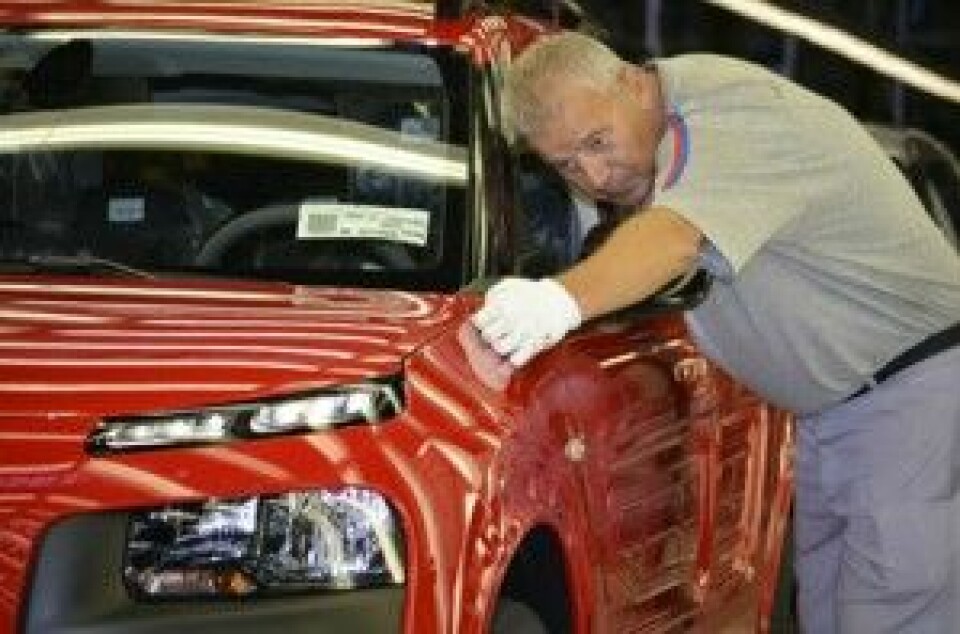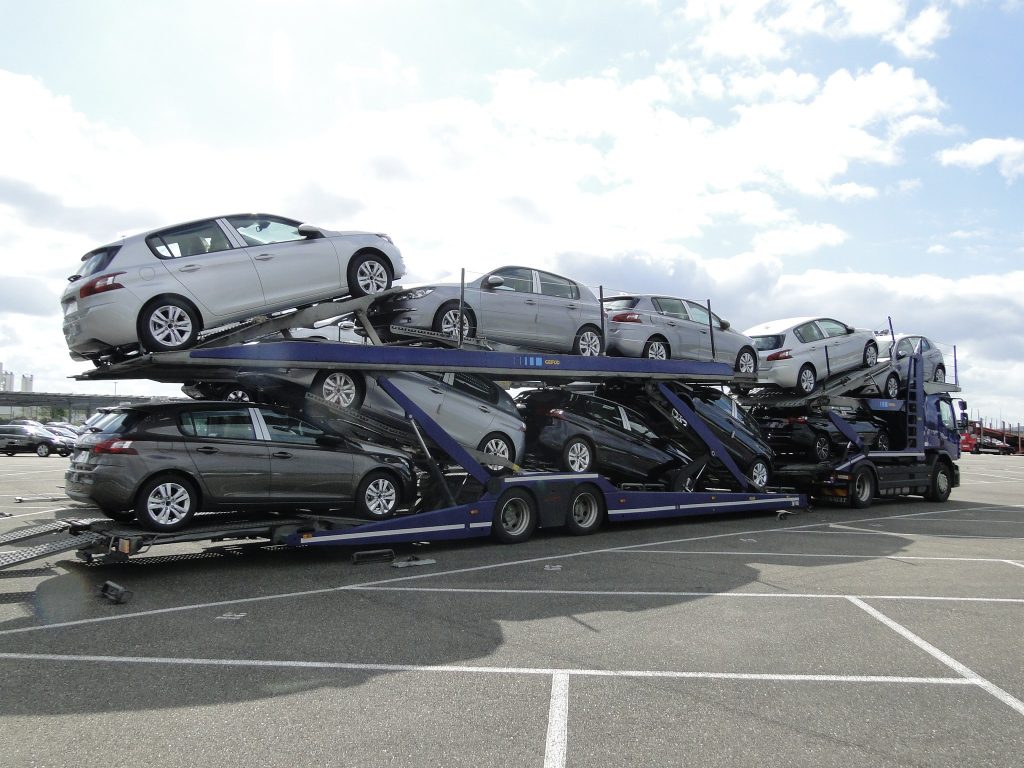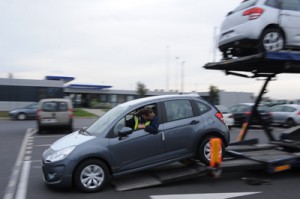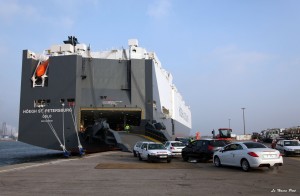Improved performance at a lower cost
 PSA Peugeot Citroën’s director for finished vehicle supply chain Guy Lederer (left) describes how his goals to reduce stock and delivery lead times are at the heart of efforts to put the OEM ‘Back in the Race’
PSA Peugeot Citroën’s director for finished vehicle supply chain Guy Lederer (left) describes how his goals to reduce stock and delivery lead times are at the heart of efforts to put the OEM ‘Back in the Race’
The past year has been a transformative one for PSA Peugeot Citroën. Many parts of the story are by now familiar: the decline of the European market and a severe cash shortage led to a restructuring of shares in PSA, with both the French government and China’s Dongfeng Motors investing capital in Europe’s second largest carmaker. Carlos Tavares took over as the group’s chairman of the managing board and set in motion a sweep of reforms as part of his ‘Back in the Race’ strategy.
These included rationalising models, adding new plants in China, targeting new markets, and a significant cost reduction programme in Europe. Among the objectives are to sell 50% of vehicles outside Europe (up from 42% currently) as early as 2015 and to have positive free cash flow by 2016.
In this story...
- Shared responsibilities
- Gefco’s role
- Improving forecasts
- Compound consolidation
- Rail and sea, ‘wait and see’
- Going local, globally
For more on Gefco and its strategy for PSA and beyond, read our earlier interview with CEO Luc Nadal
Meeting these targets depends on the performance of every department at PSA, not least sales and manufacturing efficiency. However, the outbound finished vehicle supply chain has also come into sharp focus. For example, lowering inventories of material, especially of finished vehicles, has become a matter of survival following the carmaker’s cash flow crisis. Progress has already been made: total vehicle inventory, including dealer stocks, was 393,000 units by the end of the third quarter of 2014, about 15,000 units fewer than the same period in 2013. At the same time in 2013, just before PSA’s cash situation became dire, inventory was at 471,000 units.
Likewise, PSA’s recovery depends on taking full advantage of Europe’s fragile recovery, as well as pushing deeper into markets in Asia, Africa and the Middle East. Maintaining this growth depends, in part, on effective sales, order and delivery processes. Shorter lead times, lower shipping costs and good connections with national sales companies and distributors – especially in new markets – have become more important than ever.
Putting logistics in the race
Charged with improving these areas, Guy Lederer took on a new role, early in 2014, as PSA’s director for the finished vehicle supply chain and cash reduction programme.
As the title suggests, it’s a job that combines operational processes with a wider strategic focus. On the one hand he is responsible for managing vehicle handling and transport operations from factory through to sales compounds in the countries where PSA operates, including working with the carmaker’s logistics provider, Gefco, on getting the best cost, service and lead times. On the other hand, he has a specific objective of reducing inventory across the company, including for vehicles, production and service parts.
These are areas that Lederer says are “at the heart” of the Back in the Race strategy. “We need to have less inventory in the supply chain and we need to do it without losing any service levels to our dealers,” he says. “On top of that, we need to do it with less money.”
Such objectives may sound inherently contradictory, but Lederer’s role is to bring all these pieces together. On some levels, they mean logistics cost reductions, such as redesigning flows and better utilisation of truck and train loads with Gefco. There may also be rate savings, to be sure, but Lederer is adamant that PSA does not want to hurt its relationship with dealers by sacrificing lead times or delivery quality. “This needs to be taken into account in the price pressure put on the LSPs,” he says.

Rather than price alone, Lederer is more interested in taking a “transverse” approach across PSA and the supply chain. He reports to Jean Philippe Jombart, vice-president of supply chain, however his role involves working with plants, dealers and especially sales departments. “No one is alone in the task of reducing inventory,” he says. “It is a whole enterprise approach right now for PSA, and we’re working across many departments.”
One example of this effort is that a dedicated team, led by Michel Baur, is implementing new tools and processes focused especially on improving forecasting, stock and order management. By next year, for instance, PSA will start implementing a new ‘Interface Commerce Production’ (ICP) programme that will help dealers and logistics providers gain a more accurate view of order progress and a vehicle’s destination even before it is built.
Service guarantees
Lederer, who joined PSA in 1997, is new to vehicle logistics. However, he has considerable experience in global supply chain management, having most recently been responsible for PSA’s intercontinental parts supply chain, including the packaging and shipment of material across logistics platforms in Europe, China and South America to feed global plants. Like managing the vehicle supply chain, this network required tremendous coordination in order and inventory management as Lederer’s team supplied lean production across continents. He is now bringing aspects of analytical and engineering approaches from these operations to vehicle logistics.
“To improve the lead time for vehicles that are moving, we are trying to look at where we might be losing time within a flow,” he says. “To do that, we are putting in place exactly the same tools that we did for the intercontinental business, including flow analysis.”
"With built-to-order, you need a very high quality and accuracy of industrial organisation, such as parts inventory, and you need a longer lead time. So it is not the solution to everything" - Guy Lederer, PSA Peugeot Citroën
When it comes to managing outbound logistics, Lederer works closely with Gefco. Although PSA no longer controls the provider (it owns 25% versus 75% for RZD Russian Railways), the two have agreed a long-term, dedicated contract covering logistics for all plants and regions that PSA controls (joint ventures are not within the contract’s scope). PSA divides management of Gefco between transport operations, which fall under Lederer for outbound, and the commercial aspects of the contract that include Gefco’s rates and terms.
As with other parts of PSA’s logistics, Gefco guarantees the OEM the handling and delivery of vehicles, whether it uses its own assets or works with other providers. With the execution in Gefco’s hands, PSA focuses more on planning and processes for outbound logistics. However, there must be increasing transparency on Gefco’s decisions for logistics solutions to deliver the best balance between cost and service. Likewise, as it is Lederer and his team’s responsibility to ensure the on-time arrival of vehicles to dealers, they also determine when it is necessary to allocate more transport capacity or service to particular lanes, which Gefco has to then fulfil at the right specification, including price, quality and lead time.
From a systems integration point of view, Lederer says the arrangement with Gefco also works well. Thanks in part to their historic ownership links, PSA is highly linked to Gefco, with forecasts and orders shared automatically. “We are looking at improvements such as using RFID tags, but that is more for the long term,” he says. “We are very happy with our way of working with Gefco for outbound.”
The setup has been particularly useful as PSA looks more carefully at making changes to its logistics. At a network level, for example, the carmaker will shift its production across factories, including sharing some production with Opel. The closure of the carmaker’s Aulnay plant, near Paris, for example, has dispersed volume to other facilities. PSA has also announced reduced output at its other plant near Paris, in Poissy. Its plant at Sochaux, in eastern France, is expected to gain new production; so too will Spanish plants, notably its factory in Madrid for output of the Citroën C4 Cactus. PSA’s factories in the Czech Republic and Slovakia will also gain more production volume.

Further afield, PSA has been evaluating its network and vehicle flows further. In Russia, for example, the decline in the market has led the carmaker to reduce its local output and sales expectations. “Russia is still an extremely interesting market but has been burdened by its political and economic problems. We’re downsizing there and have had to adjust the logistics network, as have other OEMs.”
Such restructuring across Europe requires new transport flows and distribution approaches. “It drove us to think differently about the way of delivering these cars, which we are doing together with Gefco,” Lederer says.
He adds that having a dedicated provider that can help PSA secure its transport capacity has been helpful as the carmaker changes its network as well. “It is easier to make such changes with a single provider like Gefco rather than across four or five LSPs,” he says.
Lederer compares this versatility to his experience in managing parts consolidation and export centres. “We often moved our logistics platforms for consolidating parts from one point in Europe to another as the sourcing of material varied. It is also the same for moving cars – we want to have the flexibility of changing routes or compounds. Having a single provider makes such changes much easier.”
Seeing ahead more clearly
The projects for further reducing inventories will involve Gefco and outbound operations for some systems and processes. For Lederer, however, the biggest wins for reducing stocks will come from closer collaboration and integration across PSA’s commercial and industrial resources.
One of the principle problems is a lack of reliability in markets and demand forecasts – a disjoint that is not specific to PSA. Dealers and sales organisations may have concerns that they won’t get all the vehicles that they ordered by the dates they are promised, so they tend to over order vehicles or part stocks in anticipation of having enough vehicle supply. On the OEM side meanwhile, a lot of the excess inventory of parts and vehicles is also caused by uncertainties over forecasts and model types, he said.
Lederer wants to work more closely with dealers to identify their fast moving vehicles and part numbers, so that PSA can supply more of these vehicles on a built-to-stock basis, while slower moves can be built to order. “We are working with sales teams in each country to order the high runners, so that we can build them for stock,” he says. “If the stock is sold twice a month, we all win, as we can have a much faster delivery time for clients, but with lower overall inventory. It is impressive what you can do with that.”
PSA also wants to increase the number of vehicles that are built to order, however not across all segments. This method would be used for slower movers or more premium models – including the DS brand – but it would not necessarily work for the fast movers. “With built-to-order, you need a very high quality and accuracy of industrial organisation, such as parts inventory, and you need a longer lead time,” says Lederer. “So it is not the solution to everything.”
To manage this order chain effectively, confidence in the forecast and requested demand is critical. To help support this, PSA is working on the ICP programme, an order and forecasting tool that Lederer expects will play a bigger role in managing the supply chain both within PSA, at its dealers and for logistics.
Put simply, ICP will be able to adjust production and delivery forecasts on a continuous basis as vehicle orders are added to it. It will measure dealers’ orders against plant capacity and adjust forecasts in close to real time, so that the estimated delivery dates of vehicles will be more accurate at the point of order, whether it’s a car that will arrive in one week or three months. One of the key points of the system is that its inputs will come from across the sales organisations, with dedicated resources feeding the forecasts and orders in each country.
"My vision is to be able to move with the market... Sometimes we have to push vehicles hard and fast to support our dealers [even if it] means uneven flows, weighted towards the end of the month or the quarter" - Guy Lederer, PSA Peugeot Citroën
Lederer says PSA’s current ETA accuracy is actually quite good: the company produces weekly and monthly forecasts, including full specifications of options and models to plants. It has benchmarked itself against other manufacturers and has performed favourably. However, the new system will provide more continuous rather than weekly updates and forecasts. In that way, ICP will take PSA’s order visibility to a new level, including geographic destinations of units set to be produced.
“For example, Gefco will know what vehicles our plant in Poissy will be building in the following week for Italy or Spain, and thus will know exactly how many trucks it should hire,” says Lederer. “This is something we are working on to help people to be really in charge of their operations by having the best possible information.”
He adds that PSA would then expect some of the savings that Gefco would make in more accurate planning to be passed back to the carmaker.
The potential (and risk) of combining stocks
PSA is also looking more carefully at its sales and stockholding strategies in countries across Europe. In larger markets such as France, the UK, Germany and Spain, for example, the OEM has multiple vehicle compounds, using a somewhat decentralised approach to meeting demand as quickly as possible. In response to changing demands, this network is being evaluated more carefully. “We’re looking at whether we might need more or fewer compounds in these markets depending on the sales and evolution in each country,” says Lederer.

In other cases there may be potential to combine vehicle compounds or to centralise inventory across a number of countries before delivery to dealers or local yards. “We do now integrate multi-country vehicle compounds in some areas, and a more regional approach to our sales organisation has helped us to do that. It is something we are currently working on and evaluating further,” Lederer says. “One example is across Spain and Portugal, where we have consolidated our stock from a regional point of view.”
In many ways, Lederer is a believer in combining inventory insomuch as it possible, as it not only helps to consolidate resources and management, but can also be effective in arranging truck and rail transport. However, consolidation of vehicles is not always the best result for sales, he admits. “The major thing is management of stock at a deep and close level. We can bring the stocks together but if nobody is properly responsible for it, it can be a mess.
“It is fine to mutualise the stocks, but you need to have a clear contract between the two – or more – parties,” he adds.
However, the process has its limits. For example, vehicle tastes and preferences differ between even Spain and Portugal. “This raises questions over how you would manage stock. You have to look very carefully at the processes to make sure that you don’t end up taking stock from one market to the detriment of the other,” he says.
Getting this balance right is crucial since, for PSA as much as, if not more than others, maximising sales potential across Europe is essential. A fast and flexible network is a priority. At the time of writing, the carmaker is slightly outperforming the overall European market, with a sales rise of around 9% in the first ten months of the year compared to 2013, despite the continuing problems in the French market.
“My vision is to be able to move with the market. The overall European market may be relatively stable, but locally, in particular markets or areas, it is moving very quickly,” he says. “Sometimes we have to push vehicles hard and fast to support our dealers. It often means uneven flows, weighted towards the end of the month or the quarter. But that is the game, I’m afraid, and we have to respond to it.”
Waiting on rail and seeing about sea
Another area in which Lederer is “very open” to changes is in multimodal transport in Europe, including rail and short-sea distribution. The carmaker’s use of rail and short sea is already relatively high, and Lederer says the services work well and are reliable. “We’re very willing to go a step further with rail, but it needs to be worked on from an overall point of view across Europe,” he says, pointing out that rail is sometimes restrained and slowed down by a lack of integration across European countries.
For short-sea shipping, Lederer acknowledges that the implementation of the low sulphur emission zone in much of northern European waters starting in January 2015 is “a risk” for PSA. At the time of writing in December 2014, some shipping lines have already cancelled ferry services or announced price adjustments, although the full impact on shipping services is not yet clear. “We are still looking together with Gefco at how this might really affect our business, but it not easy yet to understand,” he says. “To summarise it in a very English way, we have to ‘wait and see’.”

Another opportunity for PSA’s transport network, including multimodal flows, is its partnerships with Opel and GM Europe. For more than year, Gefco has been operating as the 4PL provider for GM across Europe, and part of its objective has been to combine transport and distribution with PSA where feasible. According to Lederer, there is potential here, including for balanced truck or rail flows from different plant locations in Spain or from Germany. However, he imagines that more opportunities will come as the carmakers deepen their alliance with the production of common vehicles in 2016. He envisions more vehicles shared on block trains or shipping routes, for example.
Local control for global processes
There are many technical aspects involved in improving PSA’s vehicle logistics and inventory levels, including systems and network engineering. However, Lederer also points to cultural changes across the company. Its overall management and sales structures are becoming more regional, for example, rather than coming under a central PSA umbrella. “This will also be a challenge for our supply chain and in establishing new ways of working,” he says.
For example, joint ventures with Dongfeng will be responsible both for vehicles produced and imported in China, and exports to countries in Southeast Asia. “It makes more sense to serve countries like Malaysia or Indonesia from China than it does from France or Spain,” says Lederer.

That means not only that more vehicles will be built and shipped within Asia, but also more management and strategic decisions must be made well beyond the reach of Paris – something that was inevitable with the Dongfeng investment in PSA. “We can no longer imagine that we can teach the Chinese or Asians the best way to run their business locally” he says. “They know their markets well and are responsible for their objectives.”
That is particularly the case for the domestic Chinese market, which is fast becoming one of the most important for PSA. Sales in the first ten months of 2014 were up more than 30% compared to 2013 across joint ventures with Dongfeng and Changan and a fourth plant with Dongfeng is being built in Chengdu.
Vehicle logistics within China is managed and controlled by the joint ventures, while PSA shares best practice and helps support launches and new projects. The work that Lederer and his team are doing on reducing inventory and lead times, including implementing the ICP programme, will be shared with the joint ventures. However, Lederer points out that, with the focus in China on growth, the objectives are different to those PSA currently has in Europe.
“We are fully discussing our global processes with the Chinese joint ventures and they are interested, but their cash situations are quite different, and the focus is much more on meeting demand and rising volumes rather than necessarily lowering inventory,” he says.
"We can no longer imagine that we can teach the Chinese or Asians the best way to run their business locally. They know their markets well and are responsible for their objectives" - Guy Lederer, PSA Peugeot Citroën
Elsewhere, as PSA grows sales and exports to other emerging markets, such as the Middle East and Africa, importers and distributors will play a larger role, which again means that PSA and Gefco may have less control over all aspects of the supply chain. A more open and collaborative approach is necessary, says Lederer.
“We expect to work more and more with different groups of people and types of organisations abroad, which will be a new challenge in delivering the best service, price and quality.”
For Lederer and the wider supply chain team, adjusting to PSA’s new reality may take some time, however it is a task that he feels all departments are committed to. Vehicle logistics and the outbound supply chain are very much a part of the Back in the Race plan, with no one less than Tavares himself taking a special interest in the results. However, as difficult and demanding as these requirements are, Lederer says Tavares’s supply chain knowledge and attention is encouraging.
“Carlos Tavares is very involved in all of the operational processes, and he considers the supply chain and inventory management to be critical processes,” he says.





